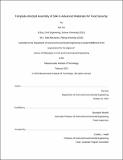Template-directed Assembly of Silk in Advanced Materials for Food Security
Author(s)
Sun, Hui
DownloadThesis PDF (12.84Mb)
Advisor
Marelli, Benedetto
Terms of use
Metadata
Show full item recordAbstract
The ability to provide sufficient, safe and nutritious food to the global population, which is projected to reach 9.7 billion by 2050, is becoming a major challenge for agriculture, especially under the pressure of climate change. Motivated by the pressing need to ensure food security for the fast-growing population, this thesis is dedicated to bringing biomaterials-based innovation in agriculture and food production, by developing new ways of nanofabrication with structural biopolymers (e.g. silk proteins) to generate macroscopic yet nanostructured functional materials that can be interfaced with food and plants. Inspired by the way living systems regulate disorder to order transition of biomacromolecules to achieve complex materials, a template-based directed assembly approach is developed to guide hierarchical materials growth from disordered molecules all the way up to macroscale, a process hereby termed templated crystallization. Using silk fibroin as an example, templated crystallization refers to the employment of organic templates (specifically, ordered peptide seeds) to drive a phase transformation of silk molecules from disordered to ordered conformations, followed by directed assembly of the reconfigured fibroin chains into higher order structures (e.g. β-sheeted nanofibrils). Modulation of the relative concentration between silk fibroin and the peptide seeds, silk fibroin molecular weight and pH allows for precise control over nanofibrils morphologies and mechanical properties. More importantly, silk polymorphs can be engineered by varying the peptide seeds used. Further, integration of the bottom-up templated crystallization with rapidly scalable top-down manufacturing enables generation of macroscopic nanostructured materials with potential applications in information encryption, surface functionalization, and printable three-dimensional scaffolds of customized architecture and controlled anisotropy. In particular, by integrating silk polymorph design with physical unclonable functions (PUFs), a cryptographic protocol based on PUF tags made of silk microparticles is developed for authentication of agricultural goods (e.g. seeds). Finally, nanostructured silk membranes composed of vertically aligned silk nanotubes and nanopillars are fabricated by template wetting-guided material assembly, with applications in anti-fouling, oil-water separation and as packaging materials with improved gas barrier properties.
Date issued
2023-02Department
Massachusetts Institute of Technology. Department of Civil and Environmental EngineeringPublisher
Massachusetts Institute of Technology